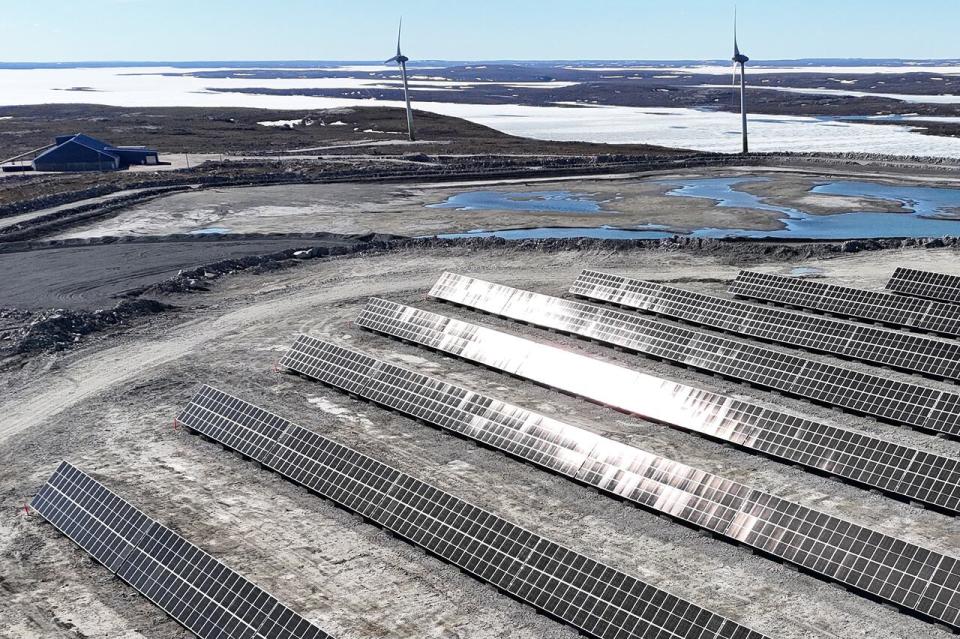Diavik's solar plant is running. Officials hope it can be 'deployed elsewhere' when mine closes
Rio Tinto says its 3.5-megawatt solar plant, which it calls the North's biggest off-grid solar operation, is up and running at Diavik Diamond Mine in the N.W.T.
The 6,620 solar panels are expected to generate 4.2 million kilowatt-hours of electricity per year, according to a press release from the company — amounting to 25 per cent of the electricity needed for closure work that's slated to happen between 2026 and 2029. Currently, while the mine is still in production, the plant is generating 2.3 per cent of its electricity.
Gord Stephenson, Diavik's senior manager of surface operations and closure, said it was a relief to turn the plant on for the first time. Rio Tinto said in a media release construction on the project began in February. Solvest Inc., a solar energy company in Whitehorse, and Tlicho Investment Corporation were contracted to do the work.
Stephenson described building the plant as a considerable logistical undertaking, which involved having the solar panels brought in earlier this year on a winter road and piecing everything together over a few months.
He said the solar panels are organized in 23 rows and span a swath of land that's equivalent to seven city blocks.

The panels are said to be bi-facial, meaning they'll generate energy directly from the sun but also from the light reflected off the snow during the winter. They've also been built in mesh wire baskets that are filled with gravel so they can be moved.
Stephenson said Rio Tinto is looking for a "suitable partnership" so the infrastructure can be "deployed elsewhere" once the mine closes. By the time that's expected to happen, the panels will still have 25 years of operational life left.
"Certainly not looking to profit off of the solar panels," he said, when asked what type of partnership the company was hoping to strike. "More in the nature of the positive legacy aspect, I think that would be the most constructive … but we haven't made any commitments yet."
Rio Tinto becomes 1st to use heavy emitter grant
Most of the money for the project — $3.3 million — comes from carbon tax Rio Tinto paid to the N.W.T. government over the last several years.
The territory held part of each diamond mines' carbon taxes between 2019 and 2023 and put it into a large emitter grant program — allowing the mines to access those funds again for greenhouse gas reduction projects. The territory did not put any of its own money into the grant.

Caroline Wawzonek, the N.W.T.'s finance minister, said Diavik is the first of the N.W.T.'s mines to use the fund. She said the solar plant becoming operational is exciting for a variety of reasons, including for what she describes as a "huge" reduction in emissions.
Rio Tinto said the solar plant will offset 1 million litres of diesel per year and reduce emissions by 2,900 tonnes of carbon dioxide per year — the equivalent of taking 630 cars off the road.
"To have that kind of reduction from an alternative energy source I think is really exciting," Wawzonek told CBC News. She said it's difficult for governments and small communities to be the first out the gate with new technologies, so for industry to prove new forms of technology works is helpful for those looking for energy alternatives.
Wawzonek said the N.W.T. government is no longer allowed to have heavy emitters contribute to the grant fund because of a federal change which she considers "tricky" to understand.
According to the territory's latest carbon tax report, Gahcho Kue has amassed nearly $2.1 million in the fund, and Ekati has amassed nearly $2.2 million. Wawzonek said both have made serious inquiries about using those funds as well, and they have until spring 2028 to do so.
Rio Tinto previously said its solar panel project would be the biggest in the North. It now claims to be the biggest off-grid solar plant in the North — Stephenson said a grid-connected solar project built in the Yukon last year is generating more power than Diavik's plant is.


